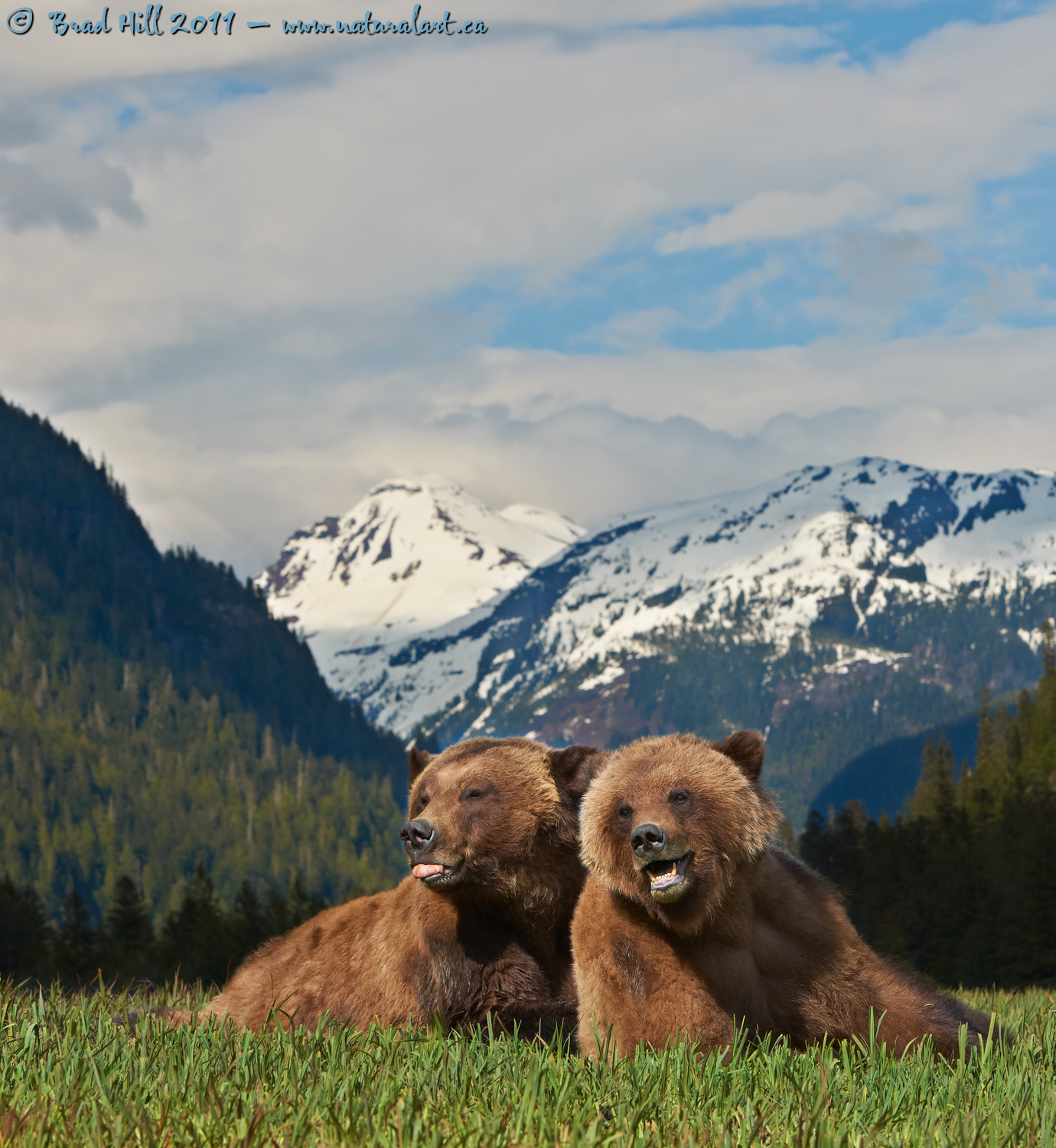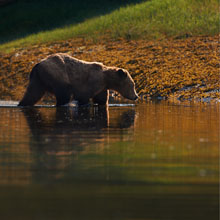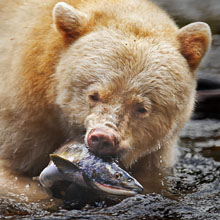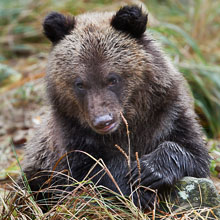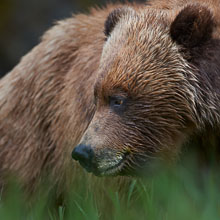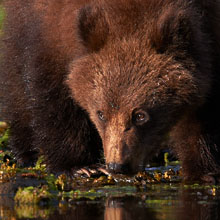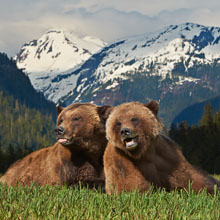Availability: Undetermined - Enquiries?
In the Field
Sharing an Inside Joke. Khutzeymateen Inlet (Great Bear Rainforest), BC, Canada. May 25, 2011.
So why do these bears appear so darned happy? Well, I think it's totally obvious - the bear on the left (a male) is trying to impress the fine looking female he's sitting beside with a bit of an inside joke - I only caught a bit of the punchline, but it ended with "...and you wouldn't believe how BAD that two-legged upright tasted - YUK!" Apparently she liked the joke...
In a sense this image is very "not me"...you know - "off-brand". I normally prefer images that have anything BUT front lighting, and I tend to gravitate toward lighting that is much more "moody" than in this shot. And while this scene DOES capture some aspects of the Khutzeymateen Inlet where I travel to each spring, it's almost a little too "cliche" for my taste. So...why did I shoot it (and present it here). Well, for a number of reasons...
I've mentioned several times on this website that I went into the Khutzeymateen Inlet in spring 2011 looking for images that worked in a vertical format, contained a degree of negative space, would work as a decent cover shot for a publication or could stand alone, and were both simple and moody. Well...if you consider "happy" as a mood, this image would qualify on all accounts. I could be easily convinced that happy IS a mood, but I don't think of it in the same way as I do "moody", especially when that word is used to describe an image (as in "a moody image"). But, most importantly, I had a client who wanted everything on this list too, but made it real clear they wanted a "happy shot". So...CHECK - here ya go (and the client DID love the shot!). Well...most of us - including me - do live in the "real world" and we can't always just shoot to please ourselves. Sigh...
But if this isn't the type of image I like shooting (or want to be known for) why post this image on my website? Because I ran into a very unique "problem" to solve when processing this image (and one I had never seen before). It's common knowledge that I regularly perform "exposure blends" (multiple raw conversions from a single file that differ in their exposure values and that are later blended in Photoshop). But with this image I was forced to produce a "white balance blend" to return the image to how I remember it looking in the field. Huh? When I first opened this image in my raw converter, it chose a VERY warm white balance (6174 degrees K). At that setting the background looked perfect, but the foreground (bears and grasses) were far too warm. I monkeyed with the white balance until the foreground looked right - which turned out to be 4894 degrees K. And, at that setting the background was WAY too cool! So I solved the problem by making my first "white balance blend" where the background was processed from raw using one set of white balance values and the foreground with another set of values. And, of course, I blended the multiple images using Photoshop.
So what happened with the white balance of this image? I can't say I'm completely sure. I do shoot in Auto White Balance mode for all my outdoor work (I don't find it effective indoors, but it works well with naturally-lit scenes). If you look closely at this scene you'll notice that the sky is partially filled with clouds and that some parts of the scene are in the shade (produced by the patchy cloud cover). I'm guessing that the differing fore- and background white balances were produced because areas on the ground had differing thickness of cloud cover separating them from the sun (notice the thin wisps of cloud covering even the "blue" portions of the sky) and that this differentially impacted on the white balance of the foreground and background. Just what you need - one MORE thing to watch for in your photography!!
ADDITIONAL NOTES:
1. This image - in all resolutions - is protected by copyright. I'm fine with personal uses of them (including use as desktop backgrounds or screensavers on your own computer), but unauthorized commercial use of the image is prohibited by law. Thanks in advance for respecting my copyright!
2. This image was captured during one of my two spring "Grizzlies of the Khutzeymateen" photo tours in May/June of 2011. Each year I offer trips into two different parts of the Great Bear Rainforest as well as one to photograph aquatic mammals and oceanscapes near the northern tip of Vancouver Island. And, in selected years, I also offer photo tours to locations to capture other highly sought-after subjects, such as various boreal owl species and wildlife of Canada's Arctic. Details about these trips can be found on the Photo Tours page of this website.
3. Like all wildlife photographs on this website, this image was captured following the strict ethical guidelines described in The Wildlife FIRST! Principles of Photographer Conduct. I encourage all wildlife photographers to always put the welfare of their subjects above the value of their photographs.
Behind the Camera
Sharing an Inside Joke. Khutzeymateen Inlet (Great Bear Rainforest), BC, Canada. May 25, 2011.
Digital Capture; RAW 14-bit format; ISO 110.
Nikon D3x with Nikkor 70-200mm f2.8 VRII zoom lens (@ 110mm) with B&W circular polarizing filter- handheld.
1/250s @ f11; -1.0 stop compensation from matrix-metered exposure setting.
At the Computer
Sharing an Inside Joke. Khutzeymateen Inlet (Great Bear Rainforest), BC, Canada. May 25, 2011.
RAW Conversion to 16-bit TIFF, including first-pass/capture sharpening using Phase One's Capture One Pro 6. Two raw conversions varying in both white balance and exposure settings over a 1.25 stop range - background at 6174K and 0 stop exposure compensation and foreground (bears and grass) at 4895K and +1.25 stop exposure increase.
Further digital corrections on 16-bit TIFF file using Adobe's Photoshop CS5 and Light Craft's LightZone. Photoshop adjustments including blending of 2 white balance/exposure versions, selective tone curve adjustment, selective colour saturation and desaturation, and final sharpening for web output. Final tonemapping and contrast/tone tweaking performed with LightZone using the tonemapper/re-light tool.
Conservation
Sharing an Inside Joke. Khutzeymateen Inlet (Great Bear Rainforest), BC, Canada. May 25, 2011.
Ten percent of the revenue generated by this image will be donated to Raincoast*.
Species Status in Canada**: Special Concern (May 2002).
While Grizzly Bears (Ursus arctos) are not technically listed as "Endangered" in Canada, they have been extirpated from most of their historical range. Grizzly Bears are far more sensitive to intrusion/disturbance in their habitat than are Black Bears and are being increasingly forced into marginal habitat by human encroachment. The Great Bear Rainforest along the central and northern coast of British Columbia is one of the last strongholds of the Grizzly Bear in Canada, and even this population is coming under increasing pressure.
On December 18, 2017 the government of British Columbia banned grizzly hunting across the entire province. This major conservation victory came after decades of tireless work by many dedicated conservationists and ecologists and, most importantly, it reflects the opinion of the vast majority of British Columbians. And, it means that AT LEAST while the current government remains in power grizzlies are finally "safe" in British Columbia.
Now that we've at least temporarily won the battle to save grizzlies in BC, it's time to re-focus our efforts toward protecting ALL of BC's carnivores, including Gray Wolves, Black Bears, Cougars, Wolverines, and more! Simply put, there are no ecological, economic, or ethical arguments supporting the trophy hunting of carnivores.
In a great first step towards ending the hunting of carnivores throughout BC the Raincoast Conservation Foundation has developed a program designed to protect ALL carnivores within the Great Bear Rainforest. Details about this program can be found on this page on Raincoast's website. Check it out and, better yet, make a donation to help Raincoast purchase the remaining commercial hunting tenures in the Great Bear!
*The Raincoast Conservation Society (and Foundation) is an effective and efficient organization that has been fighting for protection of this unique habitat. If you are looking for a meaningful way to contribute to the conservation of this amazing ecosystem, Raincoast will provide maximal "bang" for your conservation dollars.
**as determined by COSEWIC: The Committee on the Status of Endangered Wildlife in Canada












